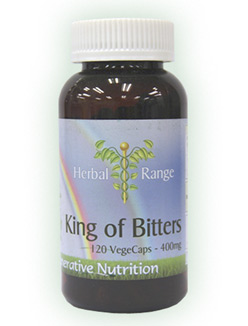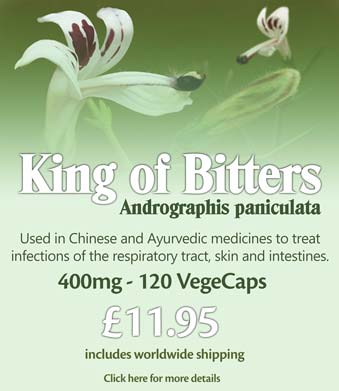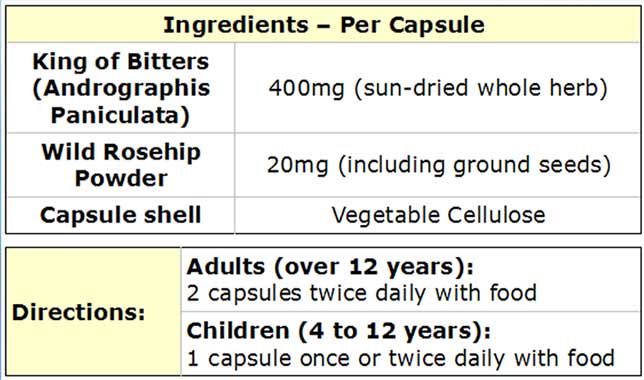
|
Andrographis Paniculata, The King of Bitters, is indeed a master herb and as such is used in 26 different Ayurvedic formulations to treat liver disorders. The herb improves liver and gall bladder function, increases bile flow (thereby aiding digestion), and has been found to be as effective as silymarin (the active component of Milk Thistle) in aiding liver function when the liver is toxic or under stress. As a potent anti-bacterial and anti-viral herb it may be used to help overcome the effects of Hepatitis.
It is also a potent anti-inflammatory, helps boost the immune system, protects against cancer, prevents blood clots and maintains efficient digestive functioning. It has been beneficial in numerous health applications, some of which are listed below.
|
|
Asthma |
Colitis |
Sore Throat
|
|
Autoimmune disorders |
Coronary Heart Disease |
Biliary Colic |
Viral & Bacterial Infections
|
Circulatory Disorders |
Influenza, Colds & Coughs
|
|
Bronchitis |
Ulcerative Colitis
|
Sinusitis
|
|
Candida Albicans &Thrush |
Digestive Problems |
Colic
|
|
Cardiovascular Disease |
Liver Congestion
|
Parasites &Worms |
King of Bitters activates fibrinolysis, a natural process in the body in which blood clots are dissolved. It also relaxes the smooth muscle in the walls of blood to help lower blood pressure. Major affinities are for the heart, liver, gall bladder and to aid digestion and to help boost immune system and eliminate infections including malaria. May also be used as part of a gallstone removal program.
As an Ayurveda herb it is known as Kalmegh or Kalamegha, meaning "dark cloud". It is also known as Bhui-neem, meaning "neem of the ground", since the plant, though being a small annual herb, has a similar strong bitter taste as that of the large Neem tree (Azadirachta indica).
In Malaysia, it is known as Hempedu Bumi, which literally means 'bile of earth' since it is one of the most bitter plants that are used in traditional medicine.
Since ancient times, King of Bitters has been used in traditional Siddha and Ayurvedic systems of medicine as well as in tribal medicine in India and some other countries for multiple clinical applications. The therapeutic value of Kalmegh is due to its mechanism of action which is perhaps by enzyme induction.
Andrographis is an herbal medicine derived from the Andrographis Paniculata shrub grown the moist, shady areas of India, China and throughout Southeast Asia. It is commonly referred to as 'Indian Echinacea' and is a popular Ayervedic and Chinese household remedy for the common cold, digestive issues, upper respiratory tract infections, flu and other sicknesses typified by fever. Although its use dates back easily a thousand years in these ancient medical traditions, there is a more recent historical reference to its potency.
In the Indian flu epidemic of 1919, the herb Andrographis is credited with the reversal of its onslaught. More recently, it popularity has spread to Scandinavia, where its dosages have been standardized and it has been widely recommended by doctors for two decades as a common remedy in treating these same winter ailments. As research increases, so does our understanding of Andrographis' many activities and indications are that it may even play a role in cardiovascular and cancer treatments.

A potent anti-inflammatory, anti-bacterial and anti-viral effects. In addition, scientists have discovered that Andrographis paniculata helps boost the immune system, protects against cancer, prevents blood clots and maintains efficient digestive functioning. Useful in upper respiratory infections, fever, sore throat and herpes. Other reported applications include its use in cases of malaria, dysentery and even snakebites.
The main active constituent in andrographis is andrographolide, which in herbal medicine is referred to as a 'bitter' principle - so called because of its bitter taste. Indeed, andrographis is known as the 'King of Bitters'. Bitter herbs generally have an affinity with the heart, liver and gall bladder and most have a cooling effect on the body and can bring down a temperature.
Andrographis paniculata (AKA Indian Echinachea) is one of the most commonly used medicinal herbs in traditional Indian medicine, or Ayurveda, and also in Chinese herbalism. The plant is an annual in India and grows to between 1 and 3 feet tall. This versatile herb has been used to treat a wide variety of health conditions, some of which have been substantiated by scientific research.
Andrographis and its various components have demonstrated a variety of effects in the body. Aspects stimulate the general immune activities, others inhibit the body's inflammatory mechanism and still others demonstrate not only anti-microbial abilities, but also are instrumental in killing certain tumor cells. Studies have also indicated that the active chemical, Andrographolide, helps to stop the clumping of blood platelets which is the clotting process that can lead to heart attacks.
King of Bitters is also reported to possess antihepatotoxic, antibiotic, antimalarial, antihepatitic, antithrombogenic, antiinflammatory, anti-snake venom, and antipyretic properties to mention a few, besides its general use as an immunostimulant agent.
The suggested dosage for andrographis is 400mg - 800mg twice a day (for up to 10 days). Although andrographis has been found to be safe in humans, animal studies suggest it may impair fertility. Safety in young children and pregnant or nursing women has not yet been established.
The Common Cold, Influenza and Sinusitis
As a preventative for the common cold, studies show that andrographis may increase the body's resistance to infection by stimulating the production of antibodies and macrophages - large white blood cells that scavenge foreign matter. To date, the herb is best known in Western society as a popular over-the-counter alternative remedy for the common cold. Several double-blind clinical trials have shown that andrographis can reduce the severity of symptoms. In one study involving 158 participants, andrographis or placebo was given daily for 4 days. By the second day those taking the herb showed significant improvements as compared to those given the placebo. Improvements were seen in relation to sleeplessness, nasal drainage and sore throat. In a three-month trial involving 107 students, 54 of the participants took 100mg of andrographis twice daily, while the remaining students were given placebo. At the end of the trial only 16 students in the andrographis group experienced the signs of a cold, compared to 33 in the placebo group.
In one Chilean study, the herb had a significant drying effect on the nasal secretions of cold sufferers who took 1,200 milligrams of andrographis extract daily for five days. A systematic review of the literature and meta-analysis of randomized controlled trials also suggested the herb alone or in combination with eleuthero may be an appropriate alternative treatment of uncomplicated acute upper respiratory tract infection.
Cardiovascular Health
Andrographis promotes a healthy heart by preventing blocked arteries and blood clots. According to studies in China, andrographis is effective in preventing the formation of blood clots. Further research shows that the herb activates fibrinolysis, a natural process in the body in which blood clots are dissolved. It also relaxes the smooth muscle in the walls of blood vessels and has a blood pressure-lowering effect.
Cancer
Scientists today are focusing on the herb's application in treating the 'killer' diseases that blight modern life, such as heart disease and cancer. Andrographis extracts are cytotoxic (cell-killing) against cancer cells. Positive results have been seen in relation to stomach, skin, prostate and breast cancer cells in test-tube studies. In fact, recent laboratory tests in New York have demonstrated that andrographis may inhibit the growth of human breast cancer cells just as well as the drug tamoxifen.
A study has been conducted on the cellular processes and targets modulated by andrographolide treatment in human cancer and immune cells. Andrographolide treatment inhibited the in vitro proliferation of different tumor cell lines, representing various types of cancers. The compound exerts direct anticancer activity on cancer cells by cell cycle arrest at G0/G1 phase through induction of cell cycle inhibitory protein and decreased expression of cyclin dependent kinase 4 (CDK4) Immunostimulatory activity of andrographolide is evidenced by increased proliferation of lymphocytes and production of interleukin. Andrographolide also enhanced the tumor necrosis factor ? production and CD marker expression, resulting in increased cytotoxic activity of lymphocytes against cancer cells, which may contribute for its indirect anticancer activity. The in vivo anticancer activity of the compound is further substantiated against B16F0 melanoma syngenic and HT 29 xenograft models. These results suggest that andrographolide is an interesting pharmacophore with anticancer and immunomodulatory activities and hence has the potential for being developed as a cancer therapeutic agent. Further, Andrographolide could be developed as a therapeutic agent to treat both androgen-stimulated and castration-resistant prostate cancer.
Upper Respiratory Tract
Andrographis has been shown to be a safe traditional botanical for supporting upper respiratory tract health, per analysis of seven double-blind controlled trials. The herb has been shown to inhibit RANTES secretion in inflamed bronchial cells. RANTES is a chemoattractant for eosinophils, monocytes and lymphocytes that are stored in, and released by, platelets and activated T-cells. In related research: Andrographolide, an active ingredient in Andrographis, has been shown to be responsible for the herb's inflammatory modulating actions, including the reduction of cytokine and peritoneal deposition of neutrophils, and modulation of lung inflammation in vivo. Extracts of Andrographis exhibit potent inflammatory modulating and antioxidant actions in mouse models.

Skin Conditions
Andrographis paniculata is recognized for its purported blood-purifying properties and has been used in traditional Asian medicine to treat conditions believed to be related to impurities in the blood, such as boils, scabies and other skin conditions.
Chronic Fevers
Andrographolide, an active ingredient in Andrographis, has been shown to be responsible for the herb's anti-inflammatory actions, so easing chronic fevers according to Shahid Akbar, M.D., Ph.D, writing for the 2011 issue of the journal "Alternative Medical Review."
Antiviral
Andrographolide and two related compounds showed antiviral properties against herpes virus in a study conducted by the Faculty of Pharmaceutical Sciences, Khon Kaen University, Thailand. All three were less than 50 percent effective at preventing infection with the virus. However, one of the compounds totally inhibited the virus after infection was established and another was moderately effective at inhibiting the virus post-infection. The compound that exerted complete inhibition of the virus stopped the virus in its early phases of replication. The study was published in the May 2011 issue of the journal "Medicinal Chemistry." Andrographis Paniculata is used widely to treat fevers like chiken-guinea flu (bird flu), swine-flu, typhoid etc.
Antibacterial/Antifungal
Researchers at the Department of Pharmaceutical Chemistry, Khon Kaen University, Thailand reported on antibacterial properties of Andrographis paniculata in a laboratory study published in the January 2011 issue of the journal "Archives of Pharmaceutical Research." Andrographolide and its derivitive molecules were tested against several bacteria and Candida albicans, the organism responsible for many yeast infections. The bacteria Bacillus subtilis, a soil-dwelling bacteria that can contaminate food, was most effectively inhibited. Researchers noted that their experiment was the first to document antibacterial properties of Andrographis paniculata. The plant extract exhibits antityphoid and antifungal activities.
Asthma Treatment
Andrographis paniculata may be useful for treatment of asthma, according to a study conducted at the Department of Pharmacology, Yong Loo Lin School of Medicine, Singapore. In the tissue culture and laboratory animal study, a derivative of andrographolide decreased levels of eosinophils, a type of white blood cell that is triggered in asthma, and antibodies. Andrographolide is an active constituent of Andrographis. Mucus production, histamine levels, proinflammatory molecules and airway irritation were all reduced. The derivative compound was safer than andrographolide, itself, which is known to have toxic effects. The study appeared in the May 2011 issue of the "Journal of Natural Products."
Ulcerative Colitis
A recent, 2011, randomised, double-blind, multicentre,study found Andrographis paniculata as effective as mesalazine (mesalamine) in the treatment of ulcerative colitis.
How It Works
Colds, Flu, Sinusitis: Andrographis compounds have shown antivirus properties which appear to inhibit glycoprotein's in the virus. This impedes the viruses ability to invade cells in the body and replicate. It's andrographolide are currently being studied for the antiviral effects they have on avian bird flu virus and the ebola virus. It also has a major effect activating the general defense functions of the immune system by stimulating the production of antibodies as well as non-specific immune responses such as increased macrophage phagocytosis, rather than by any direct anti-microbial activity. Clinical studies have demonstrated it's efficacy fighting colds, flu, sinusitis, pharyngotonsillitis, familial mediterranean fever and upper respiratory tract infections. It also has been demonstrated to reduce the risk of colds and prevent flu and complications when used as a preventative.
Anti-inflammatory: There appears to be a significant presence of flavanoids in the Andrographis Paniculata herb, which always have an anti-inflammatory affect. In vitro studies have shown that the flavinoid activities supressed the genetic expression of neutrofils, an inflammatory agent. Similarly, studies have indicated that a variety of inflammatory proteins, including COX-2, are reduced by the presence of Andrographoloid.
Anti-tumor: In vitro andrographolide studies indicate an immuno-stimulating activity as well as a marked inhibitory effect. Its presence increases proliferation of lymphocytes and production of interleukin2, TNF-alpha production and cytotoxic activity of lymphocytes against certain cancer cell lines, as well as demonstrating potential direct anti-cancer activity by the induction of cell-cycle inhibitory protein p27 and decreased expression of cyclin-dependent kinase.
A study conducted at Bastyr University, showed a significant rise in the mean CD4 lymphocyte level of HIV subjects after administration of 10mg/kg andrographolide.
Possible Interactions
Side Effects & Safety: Andrographis Paniculata has been widely tested and is considered safe with few if any minor side effects at commonly prescribed levels. In clinical trials with children between 4 and 11 Andrographis was effective and safe. Side effects occurred in HIV trials at a dose of 10 mg of andrographolides per kg of body weight or roughly 12 time the recommended dosage.
Precautions:
Pregnant women or those trying to conceive should avoid Andrographis. Animal studies have shown the possibility of contraceptive effects at high dosage levels. Safety during breast feeding is not known.
Andrographis may increase glucose metabolisation which could unduly enhance blood sugar lowering medication. Use cautiously if taking anticoagulant agents such as warfarin (Coumadin®) or heparin, or with anti-platelet agents such as ibuprofen (Motrin®, Advil®) due to possible platelet aggregation inhibition by Andrographis.











